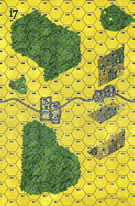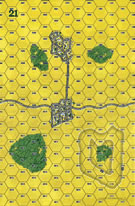|
North German Plain Hammer & Sickle #25 |
||
|---|---|---|
| (Attacker) United States | vs | Soviet Union (Attacker) |
| Formations Involved | ||
|---|---|---|
| Soviet Union |  |
18th Mechanized Division |
| United States |  |
2nd "Hell on Wheels" Armored Division |

|
| Overall Rating, 1 vote |
|---|
|
5
|
| Scenario Rank: --- of 957 |
| Parent Game | Hammer & Sickle |
|---|---|
| Historicity | Alt-History |
| Date | 1948-06-27 |
| Start Time | 06:00 |
| Turn Count | 24 |
| Visibility | Day |
| Counters | 165 |
| Net Morale | 1 |
| Net Initiative | 1 |
| Maps | 4: 1, 17, 21, 4 |
| Layout Dimensions | 86 x 56 cm 34 x 22 in |
| Play Bounty | 195 |
| AAR Bounty | 166 |
| Total Plays | 1 |
| Total AARs | 1 |
| Duplicates | IrCu005 |
| Battle Types |
|---|
| Inflict Enemy Casualties |
| Meeting Engagement |
| Scenario Requirements & Playability | |
|---|---|
| Battle of the Bulge | Counters |
| Eastern Front | Maps |
| Hammer & Sickle | Base Game |
| Road to Berlin | Maps + Counters |
| Introduction |
|---|
|
In later years, the defense of the "North German Plain" would be entrusted to British, Dutch, Belgian and German troops. In the event of war between the United States and the Soviet Union, Red Army planners realized right away that they needed to cut off American troops from the north German ports, especially Bremerhaven. Though there were other big ports available, this one had become the American port of entry and its loss would have crippled American logistics. On the flat farmlands of north Germany, tank would meet tank. |
| Conclusion |
|---|
|
Second Armored Division participated in the parade through Berlin in July 1945, and then remained in Germany for the rest of the year on occupation duties. At year's end the unit shipped back home and was de-activated, returning to the American order of battle in 1951. After 1957 it would return to Fort Hood, ready to reinforce Allied troops in Germany. On the Soviet side, 3rd Red Banner Army probably would have drawn the assignment to attack the North Sea ports - not all Soviet forces in Germany were tank-heavy organizations. |
| AFV Rules Pertaining to this Scenario's Order of Battle |
|---|
|
| 1 Errata Item | |
|---|---|

|
The reduced direct fire value in Kursk: Burning Tigers is 4-4. (plloyd1010
on 2015 Jul 31)
|
| North German Plain | ||||||||||||
|---|---|---|---|---|---|---|---|---|---|---|---|---|
After selling my copy of Iron Curtain, I had to record this older play here: I needed a real steel scenario so this one was it for me. The scenario started off with a big rock & roll thunder storm outside so a perfect setting for this battle. With the Soviets I decided on a three prong attack and whichever one had more success, I would shift my focus to. My main goal was to open up a hole, and exit troop out the North end. The leaders have to be stacked just right in this game as neither side has many and losing just one on the Soviet side would really hurt. With the Americans, I just had to get in deep enough to setup a blocking force and use the best terrain to my advantage. Also, rush the Chaffee (M24) tanks forward, in time, even if it meant their sacrifice. I believe they were the biggest factor in the game in fact. After turn one, both sides’ stacks were very vulnerable, and after turn two no shot had been fired yet. After turn three, the Chaffee were doing their job and actually shooting up Soviet armor, slowing them down to allow the Bigger American Armor, M26’s, M45’s, M3/76’s a better chance to get into better positions and the Infantry to dig-in or get into towns or forest. Not to mention getting some good cross-fire bonus points. In the end, the Soviet made several attempts but their casualties were way too high, they lost most of their Leadership on the East side and the low Morale of the Soviet’s side made it very difficult to rally the troops when they became demoralized. The American Artillery really started to breakup the Soviet Infantry and the big Soviet armor, T-44’s, JS2’s, T-34/85’s, M4A2’s & Su-76’s just got ambushed and blasted to hell. So much for the big bad wolf! Incredible Casualties: Americans lose 73 steps. Losses: 70 Armor, 1 Infantry, & 2 APC’s, also one Leader. The Soviets lose 148 steps. Losses: 140 Armor, 8 Infantry, also two Leaders They did exit 8 steps. Total American Points 148, Total Soviet Points 81! Remember tanks steps count double in all the above. The result is a Major American Victory! Final comments: when you play solitaire you always win and lose at the same time. To do it over again, I should of have two Soviet prongs and taken my time a little more. This scenario only played out about half of the turns before the Soviets retreated or waved the white flag. The American did pay a price but much smaller and mostly in armor. I see why the Chaffee tank was the best light tank in WWII. I called this game early. I think I need to try this one again someday. Fun scenario to play, win lose or draw. |
||||||||||||
| 0 Comments |

 HaSi024
HaSi024 






























